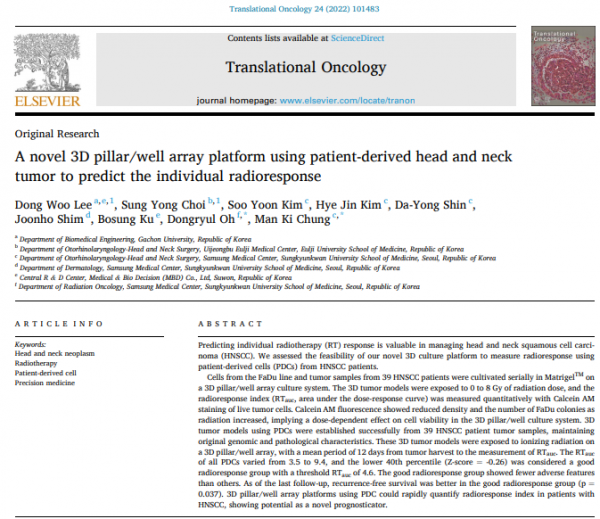Paper 2022, Translational Oncology, A novel 3D pillar/well array platform us…
Page Info

Contents
Abstract :
Predicting individual radiotherapy (RT) response is valuable in managing head and neck squamous cell carcinoma
(HNSCC). We assessed the feasibility of our novel 3D culture platform to measure radioresponse using
patient-derived cells (PDCs) from HNSCC patients.
Cells from the FaDu line and tumor samples from 39 HNSCC patients were cultivated serially in MatrigelTM on
a 3D pillar/well array culture system. The 3D tumor models were exposed to 0 to 8 Gy of radiation dose, and the
radioresponse index (RTauc, area under the dose-response curve) was measured quantitatively with Calcein AM
staining of live tumor cells. Calcein AM fluorescence showed reduced density and the number of FaDu colonies as
radiation increased, implying a dose-dependent effect on cell viability in the 3D pillar/well culture system. 3D
tumor models using PDCs were established successfully from 39 HNSCC patient tumor samples, maintaining
original genomic and pathological characteristics. These 3D tumor models were exposed to ionizing radiation on
a 3D pillar/well array, with a mean period of 12 days from tumor harvest to the measurement of RTauc. The RTauc
of all PDCs varied from 3.5 to 9.4, and the lower 40th percentile (Z-score = -0.26) was considered a good
radioresponse group with a threshold RTauc of 4.6. The good radioresponse group showed fewer adverse features
than others. As of the last follow-up, recurrence-free survival was better in the good radioresponse group (p =
0.037). 3D pillar/well array platforms using PDC could rapidly quantify radioresponse index in patients with
HNSCC, showing potential as a novel prognosticator
Predicting individual radiotherapy (RT) response is valuable in managing head and neck squamous cell carcinoma
(HNSCC). We assessed the feasibility of our novel 3D culture platform to measure radioresponse using
patient-derived cells (PDCs) from HNSCC patients.
Cells from the FaDu line and tumor samples from 39 HNSCC patients were cultivated serially in MatrigelTM on
a 3D pillar/well array culture system. The 3D tumor models were exposed to 0 to 8 Gy of radiation dose, and the
radioresponse index (RTauc, area under the dose-response curve) was measured quantitatively with Calcein AM
staining of live tumor cells. Calcein AM fluorescence showed reduced density and the number of FaDu colonies as
radiation increased, implying a dose-dependent effect on cell viability in the 3D pillar/well culture system. 3D
tumor models using PDCs were established successfully from 39 HNSCC patient tumor samples, maintaining
original genomic and pathological characteristics. These 3D tumor models were exposed to ionizing radiation on
a 3D pillar/well array, with a mean period of 12 days from tumor harvest to the measurement of RTauc. The RTauc
of all PDCs varied from 3.5 to 9.4, and the lower 40th percentile (Z-score = -0.26) was considered a good
radioresponse group with a threshold RTauc of 4.6. The good radioresponse group showed fewer adverse features
than others. As of the last follow-up, recurrence-free survival was better in the good radioresponse group (p =
0.037). 3D pillar/well array platforms using PDC could rapidly quantify radioresponse index in patients with
HNSCC, showing potential as a novel prognosticator
Related Links
- Prev
 2022, Analytical chemistry, Cell Proliferation Receptor-Enhanced 3D High-Throughput Screening Model for Optimized Drug Efficacy Evaluation in Breast Cancer Cells 23.05.22
2022, Analytical chemistry, Cell Proliferation Receptor-Enhanced 3D High-Throughput Screening Model for Optimized Drug Efficacy Evaluation in Breast Cancer Cells 23.05.22 - Next
 2022, International Journal of Molecular Sciences, High-Throughput 3D Tumor Spheroid Array Platform for Evaluating Sensitivity of Proton-Drug Combinations 23.05.22
2022, International Journal of Molecular Sciences, High-Throughput 3D Tumor Spheroid Array Platform for Evaluating Sensitivity of Proton-Drug Combinations 23.05.22

